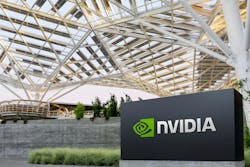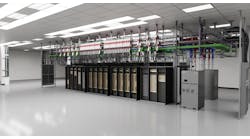NVIDIA's Data Center 'Tipping Point' Tempts A.I. Brink with Cloud Giants
In announcing financial results for its Fourth Quarter and Fiscal Year 2024, on the back of its booming AI business, NVIDIA reported record quarterly revenue of $22.1 billion -- up 22% from Q3, and up an amazing 265% from a year ago.
Chief among the results, NVIDIA reported record quarterly data center revenue of $18.4 billion, a 27% leap from Q3 while skyrocketing a stupendous 409% from the year-ago quarter, when the company's data center revenue amounted to just $3.6 billion.
In sum, NVIDIA recorded full-year revenue of $60.9 billion, up 126% from a year ago. As quoted in the company's press release, NVIDIA's founder and CEO Jensen Huang declared, “Accelerated computing and generative AI have hit the tipping point. Demand is surging worldwide across companies, industries and nations.”
Huang added that the company's data center platform is expanding based on input from increasingly diverse drivers. Huang said demand is incoming for data processing, training and inference from large cloud-service providers and GPU-specialized ones, as well as from enterprise software and consumer internet companies.
Huang added that prospects for vertical industries, led by the auto, financial services and healthcare segments, are also now at a multibillion-dollar level.
The rise of NVIDIA as an AI powerhouse didn't happen overnight. DCF reported in early 2022 on how CEO Jensen Huang had shared his vision of data centers evolving into "AI factories."
DCF's Rich Miller wrote: "Huang sees technical computing as a world-changing undertaking, sharing a vision of a future in which intelligence is created on an industrial scale and woven into real and virtual worlds."
Finally, as a chief REIT behind NVIDIA's stunning data center business growth, in providing the infrastructure that supports such rapid expansion, the role of Equinix Inc. must be taken into account, as it supplies vital data center services that support NVIDIA’s operations. The collaboration between NVIDIA and the global IBX colocation pioneer and innovator "places Equinix at the forefront of the AI and data revolution, providing investors with a direct line into the rapidly expanding digital economy," contends Bezinga's Shay Boloor.
NVIDIA Q4 Data Center Highlights
In its financial results, NVIDIA said full-year revenue for its data center segment in 2024 rose 217% to a record $47.5 billion.
In support of this impressive statistic, NVIDIA also highlighted the following areas of progress within its data center business in the time since its previous earnings announcement, regarding how the company:
- Launched, in collaboration with Google, optimizations across NVIDIA’s data center and PC AI platforms for Gemma, Google’s groundbreaking open language models.
- Expanded its strategic collaboration with Amazon Web Services to host NVIDIA DGX Cloud on AWS.
- Announced that Amgen will use the NVIDIA DGX SuperPOD to power insights into drug discovery, diagnostics and precision medicine.
- Announced NVIDIA NeMo Retriever, a generative AI microservice that lets enterprises connect custom large language models with enterprise data to deliver highly accurate responses for AI applications.
- Introduced NVIDIA MONAI cloud APIs to help developers and platform providers integrate AI into their medical-imaging offerings.
- Announced that Singtel will bring generative AI services to Singapore through energy-efficient data centers that the telco is building with NVIDIA Hopper architecture GPUs.
- Introduced plans with Cisco to help enterprises quickly and easily deploy and manage secure AI infrastructure.
- Supported the National Artificial Intelligence Research Resource pilot program, a major step by the U.S. government toward a shared national research infrastructure.
Speaking of the federal government, let's not forget how last year NVIDIA was announced as a select member of the U.S. Department of Energy's (DOE) $40 million Cooling Operations Optimized for Leaps in Energy, Reliability, and Carbon Hyperefficiency for Information Processing Systems (COOLERCHIPS) program, as supported by the agency's Advanced Research Projects Agency-Energy (ARPA-E) unit.
The COOLERCHIPS program awarded $5,000,000 to NVIDIA to develop a modular data center with "a multi-aspect innovative cooling system." The modular data center design in development cools chips with a two-phase cold plate, which achieve a thermal resistance as low as 0.0025°C/W.
Analysis
MSN/Investopedia's Stephen Wisnefski observed how NVIDIA's Q4 earnings blew past analyst expectations. "Nvidia said that revenue jumped to $22.10 billion in the quarter ending Jan. 28, compared with $6.05 billion a year earlier," noted Wisnefski. "Net income increased to $12.29 billion from $1.41 billion, while diluted earnings per share came in at $4.93, up from 57 cents a year earlier. Each of those numbers handily topped analysts' expectations."
The NVIDIA results are surprising but not shocking. Data centers know where most of those GPUs they've been clamoring for are coming from. And as people inside the data center industry keeping telling us, the pace of growth is happening fast and it's happening now.
That goes double for the cloud providers -- literally. As noted at Barron's, in the just-announced NVIDIA results, "large cloud computing providers accounted for more than half of the data center revenue for the quarter."
Of the cloud giants, as reflected by the highlights in NVIDIA's financial results, AWS last year apparently put itself in great relationship to NVIDIA, through Project Ceiba, the companies' new strategic collaboration to offer supercomputing infrastructure, software and services for generative AI.
Meanwhile, Google Cloud and NVIDIA last year announced an expanded partnership to advance AI computing, software and services, whereby NVIDIA generative AI technology used by Google DeepMind and Google Research Teams is now optimized and available to Google Cloud customers worldwide.
It might then be open question now as to which cloud titan has the larger chip-to-shoulder ratio (pun fully intended) when it comes to squaring off with NVIDIA in the arena of maximum AI: Meta or Microsoft.
Of the two, Microsoft might be the party engaging in the most immediate pushback from the NVIDIA brink, according to reporting in The Information as cited by Datacenter Dynamics, highlighting the fact that Microsoft is developing its own AI server gear to lessen its admitted reliance on NVIDIA.
The Information specifically reported that Microsoft is now developing a networking card to ensure rapid transfer of data between its servers, as an alternative to an equivalent card supplied by NVIDIA, according to an individual with direct knowledge as cited by the report.
As cited by DCD's Charlotte Trueman, "The Information reported that the Microsoft network chip will be similar to Nvidia’s ConnectX-7 card, which the chip developer sells alongside its GPUs. If the chips come to fruition, it will enable Microsoft-backed OpenAI to develop its AI models faster and more efficiently."
Further, rival chip giant Intel Corporation just announced that it will make custom silicon for Microsoft in a deal that could be worth billions. “We are in the midst of a platform shift that will fundamentally transform productivity for every individual organization and the entire industry,” said Microsoft CEO Satya Nadella.
Of course, we'd be neglectful not to also mention that Reuters report from earlier this month on a document leak in January suggesting that Meta plans to deploy a second generation of custom data center chips designed to support AI development, the better to, you guessed it, reduce the company’s reliance on NVIDIA chips.
The new chip, dubbed ‘Artemis’ by Meta, is geared for a process known as inference, where models employ algorithms to determine ranking judgments, and then generate responses to prompts from users. Artemis is bred from Meta’s AI silicon project; the company rumoured to also be working on a chip capable of both training and inference processes.
Meta representatives noted that company's AI chip technology evolution is creating more efficient processing with a 32% reduction in power consumption, in some cases.
However, as data center industry executive and commentator Nabeel Mahood of Nomad Futurist pointed out on LinkedIn, "While Meta gears up to power its generative AI ambitions, purchasing 350K H100 NVIDIA GPUs by 2024 tells us the transition to in-house will be strategic and gradual."
Given the state of the overall race for AI chip supremacy, another question might be whether or how much NVIDIA's unprecedented present financial results will go to propel its potential ambitions not just as a chip giant, but as a rival cloud giant to its largest GPU customers -- as again suggested by The Information in reporting last fall. This is a notion which has always felt bolstered by NVIDIA's vital association with alternative cloud services providers such as CoreWeave.
Responding to yesterday's announcement of financial results, commentators on CNBC Television's 'Squawk on the Street' affirmed that data center sales and revenue totals will be the key figures for investors to watch for NVIDIA going forward.

Matt Vincent
A B2B technology journalist and editor with more than two decades of experience, Matt Vincent is Editor in Chief of Data Center Frontier.





